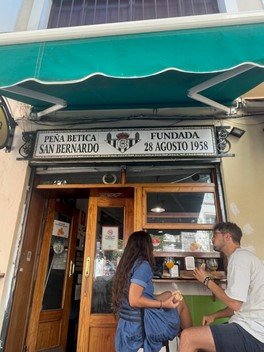The serenity of Sevilla; a city founded on the warmth of its people
At the Plaza de España
The chaos of life can be gorgeous and enticing. We are all guilty of rushing between the vibrancy of never-ending social plans, and intensity of our rewarding workloads, ending in a drastic burn-out of exhaustion. Not to mention the restraint of emotion that comes with this way of living; everything is so rushed that we are scarcely given the time of day to think about how we feel. It is becoming increasingly evident that a lifestyle like this is far from sustainable, and as we collectively seek refuge from such a frantic culture, who better is there to look to than the worldwide professionals- the residents of Seville? I was lucky enough to master the escapism of the Andalusians this summer with these very people.
Upon arrival, I was met by the sweltering heat of the Andalusian capital, along with its undeniable beauty. The gorgeous exterior of the city is most obvious in its notable sights- the Royal Alcázar, the Plaza de España and the Giralda, to name a few, - which are characterized by their Moorish and Gothic roots.
Stepping into sites like the Royal Alcazar was like entering into a conversation with Spain’s history. Finally seeing the location in which so much of the worlds, let alone Spain’s, past was shaped, was hugely emblematic. Not to mention, the striking site of the Plaza de España, and the picturesque, winding streets of the Barrio Santa Cruz (the Jewish quarter). But this wasn’t what I remember best from my trip to Seville.
No matter whether I was getting on the tram to the city centre or getting a taxi from the airport to my accommodation, the way in which Seville’s residents interact with life was unmissable.
My first stand-out experience of this was within the first few hours of arriving in Seville - sat at a small bar eating lunch, as we waited for our hotel check-in. At a first glance, the bar didn’t seem like it was anything particularly special, but once seated, its charismatic community was flagrant.
Located in the tranquil neighbourhood of San Bernardo, this bar was decorated with intricate tiles, teaching any customer that it was founded in 1958, and that it was known as ‘Peña Betica San Bernardo’. Although our wonderful waiter, who revelled in a conversation of broken Spanish and English with my parents, added to the atmosphere, it was through observing the other customers that I learnt the most.
At the Bar ‘Peña Betica San Bernardo’
In front of me were a couple, exchanging words which seemed to relax one another as they leant into the serenity of breaking for lunch; not an indulgence but rather a necessity. Elsewhere, a solitary older man sat on his moped reading a novel, pausing momentarily to look up at his surroundings and the bar facing him, then once again engrossing himself in whatever material he was reading that day.
Once I had noticed them, I couldn’t stop observing the people around me, and noticing these similar characteristics of peace and contentedness.
It’s not just the peace of Sevillan residents which contributes towards their character. It’s also their ability to express and embrace emotion, whether this is in greeting one another, or in art form, such as the flamenco. Almost everywhere you go, you are greeted with an “Hola, guapa” (Hello, pretty), an affectionate Spanish term of endearment, accompanied by wholehearted smiles, and not by ulterior motives. This presents you with an inferred permission to feel comfortable with someone you met so recently, and the flamenco most certainly feels like the personification of a warm embrace with these people whom new connections have been formed with.
Whilst ambling through the calles (streets) of Seville, it is undeniable that you will be met with various flamenco encounters, whether this is dancing, singing, or a combination of both. The first of these occurred just after I had eaten the most succulent Solomillo al whisky (Andalusian pork cooked in whisky) in the Barrio Santa Cruz, which was followed by a first glance at the Plaza de España. I had only been exploring this landmark for a few moments when, suddenly, the landscape before me lit up with the dulcet, yet simultaneously impassioned tones, of the flamenco singer, and the presence of two striking dancers. I was immediately captivated by the intensity of the art and the silence befallen on the audience watching it.
Flamenco performance at the Plaza de España
The flamenco performance which still frequently repeats itself in my mind, however, was in the Museo del Baile Flamenco (Flamenco Dance Museum). Each and every performer’s personality shone through in their flourishing display. Compelling facial expressions of both joy and anguish, along with songs performed by voices heavy with sentiment, were accompanied by the intricacies of the footwork of the dance. It is hard to explain the sensation that watching such a spectacle can bring to you; I couldn’t last five minutes without tears rolling down my face.
So perhaps you will visit Seville to see its UNESCO sites, to try a new tapas, or simply to tick it off of your bucket list of travel. All of this is normal, and perfectly commonplace. However, to even consider returning back home and saying you have experienced Seville without interacting with and observing the culture of its people, would be a disgrace to the beauty and charisma of this fine city. The people are the foundations of Seville.
All images belong to the author, unless otherwise stated.


